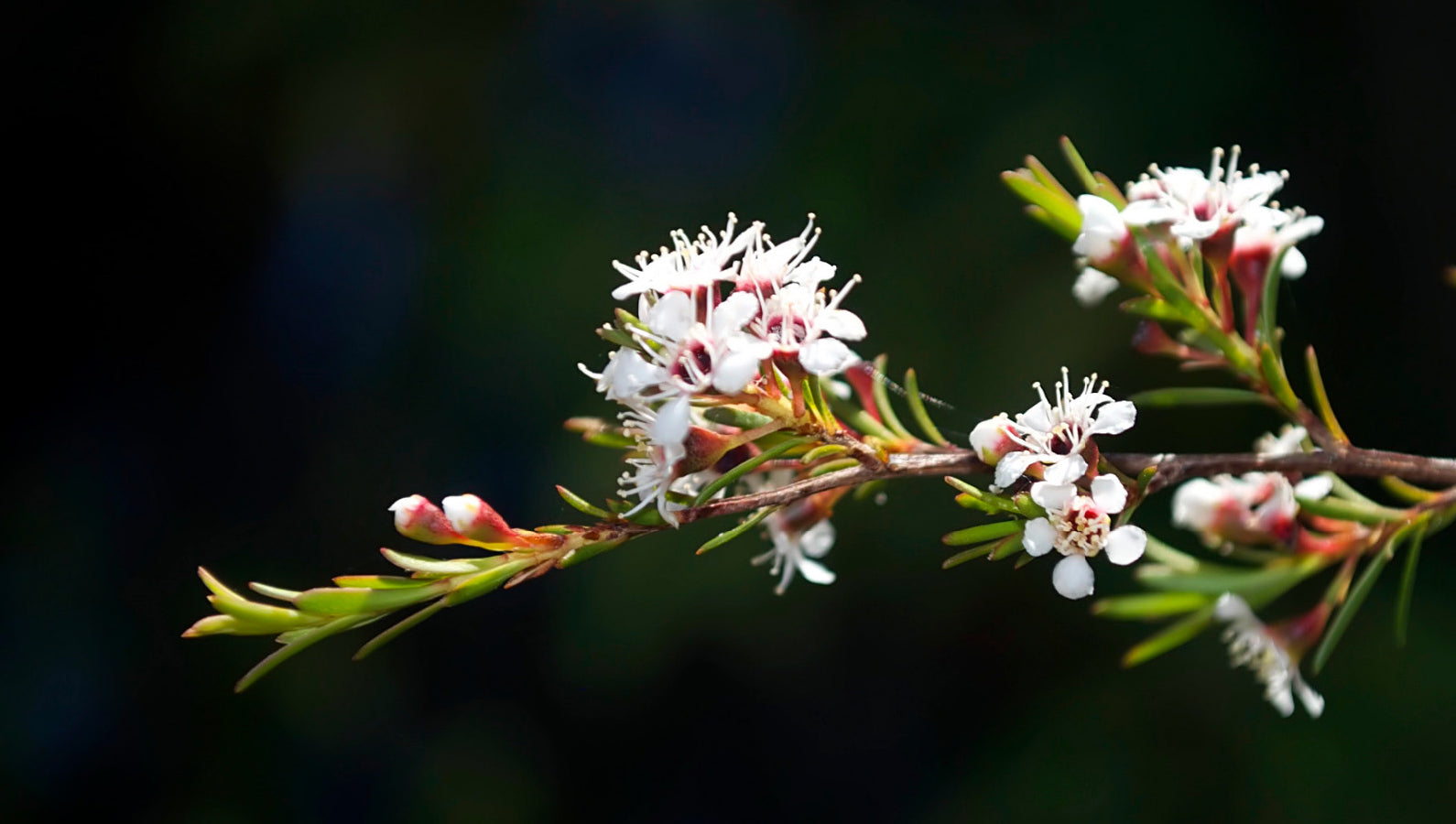It’s a very common question we get asked at Absolute Essential. Some of the confusion likely comes from Captain James Cook naming them all ‘tea tree’ when he was exploring the Antipodes. Thanks, James.
He had observed the indigenous people of Australia and Aotearoa using parts of these trees to make infusions and decoctions to treat a myriad of conditions. So, he and his crew followed suit and used the leaves to brew a type of tea.
This trio of trees are from the same family, Myrtaceae. Although they share many common properties, they are genetically quite different.
The Kānuka (Leptospermum ericoides) tree is endemic to Aotearoa and can grow up to 30 metres tall. It grows throughout Aotearoa. It sports small creamy clusters of flowers and soft, rounded leaves. The flowers give off a sweet, resinous floral aroma with a hint of crushed Eucalyptus. The bark is light brown and peels off in papery strips.

Kānuka oil is made by distilling the leaves and flowers. Kānuka oil has high levels of alpha-pinene, making it a great anti-inflammatory. ue to the key components alpha-Pinene, Viridiflorol, Limonene, 1,8-Cineol, it also boasts anti-fungal, anti-bacterial, anti-viral, and anti-septic properties. It is a very good pain killer as it is readily absorbed into the skin and is an excellent massage oil for sore joints and muscles. It is also helpful in clearing congestion and repelling insects. Kānuka oil also acts as a probiotic when taken internally, for example, when added to smoothies and salad dressings.
The Mānuka (Leptospermum scoparium) tree is native to Aotearoa. It is a sizeable shrubby tree that can grow up to 10 metres tall. It tolerates a variety of growing conditions. It is more widespread than its cousin, the Kānuka, but is especially fond of the East Coast of Aotearoa. The Mānuka that grows in this region produces a particularly potent oil, rich in compounds such as flavonoids,
Leptospermone, trans-Calamenene, Cadina-1,4-diene, delta- Cadinene and Isoleptospermone. The leaves of the Mānuka tree are spiky and dark green. The flowers are snowy white and give off a warm, gently floral scent.

Mānuka oil is made by distilling the leaves and flowers of the shrub. The production of Mānuka oil is a relatively new process, having started about 30 years ago. There is still a lot to learn about this incredible oil. What we do know for sure is that it has anti-fungal, anti-bacterial, anti-viral, anti-inflammatory, anti-microbial, and anti-septic properties, making it excellent for supporting many conditions. It was used in traditional Māori medicine to treat urinary complaints, colds and skin issues. Today, it is widely used for acne, body odour, wound healing, dandruff, insect bites, and dry skin conditions. It is also helpful in treating anxiety, stress and fatigue. A recent study[1]has found it to be very effective against gram-positive bacteria (such as Staphylococcus aureus and its antibiotic-resistant strain MRSA) and fungi. It is much safer than Tea Tree on areas of sensitive skin.
The Tea Tree (Melaleuca alternifolia) is endemic to Australia and has almost 300 varieties, ranging from 16 metres to 35 metres tall. The flowers grow in a group to form a bushy head on the end of the branches.
[1] Mathew, Cynthia et al. “Mānuka Oil-A Review of Antimicrobial and Other Medicinal Properties.” Pharmaceuticals (Basel, Switzerland) vol. 13,11 343. 26 Oct. 2020, doi:10.3390/ph13110343

Tea Tree oil is made by distilling the leaves in flower. It contains similar compounds to Kānuka oil, but they are not as strong. It has anti-fungal, anti-bacterial, anti-viral, anti-inflammatory and antiseptic properties. It also contains monoterpenes, which give the oil its distinctive herbaceous and astringent scent. The oil is very popular in hair and skincare products.
In summary, we recommend using each one for the following conditions:
- Manuka: skin conditions, especially in sensitive areas and on children and the elderly. You can boost the immune system by combining forces and mixing 1 drop with active Mānuka honey and placing it under the tongue. Repeat 2-5 times a day.
- Kanuka: is high in alpha-pinene and especially good for painful conditions, such as sore muscles. In addition, it is beneficial to the respiratory system and gut health, especially if blended with Oregano and Peppermint oils.
- Tea Tree: is high in monoterpenes, with astringent, anti-inflammatory properties, making it popular for treating skin conditions like athletes’ foot and disinfecting wounds.
We hope this has cleared up any colonial confusion over these incredibly useful cousins. To investigate further and learn how to use them, see our Encyclopedia.
